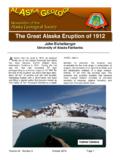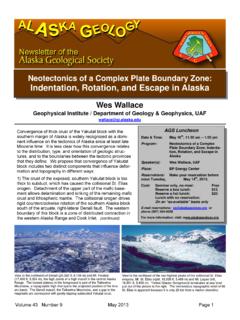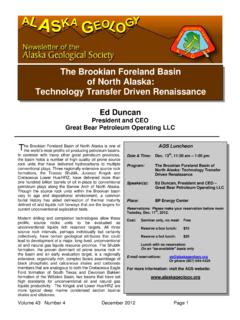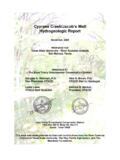Transcription of Heavy Oil Production on Alaska’s North ... - Alaska …
1 Volume 43 Number 6 February 2013 Page 1 Heavy Oil Production on Alaska s North Slope Josef Chmielowski BP Exploration Alaska Inc. AGS Luncheon Date & Time: Feb. 21st, 11:30 am 1:00 pm Program: Heavy Oil Production on Alaska s North Slope Speaker(s): Josef Chmielowski, BP Exploration Alaska Inc. Place: BP Energy Center Reservations: Make your reservation before noon Tuesday, Feb. 19th, 2013. Cost: Seminar only, no meal: Free Reserve a box lunch: $15 Reserve a hot lunch: $20 Lunch with no reservation: On an as-available basis only E-mail reservations: or phone (907) 564-4028 For more information: visit the AGS website: The Alaska North Slope is a prolific hydrocarbon basin that has produced billions of barrels of light oil. As the basin matures and Production declines, it is necessary to investigate other means by which to extend field life. As a result, BP Alaska has appraised the fluvial-deltaic Ugnu reser-voir and associated Heavy oil fluids in order to demonstrate the technical viability of producing Heavy oil on the North Slope.
2 In 2011 & 2012, the large Heavy oil resource (approximately 18Bn bbls.) has been tested via a four well Production pilot. Due to limited surface locations and perma-frost issues, two horizontal wells with surface drive progressive cavity pumps were selected for ap-praisal of the Ugnu Formation. Acquisition of quality data and a proactive approach to well man-agement allowed up to 20% sand Production to be sustained over the test period. Data will be shown to demonstrate the improvement in performance relative to conventional horizontal predic-tions and how the sand Production is enhancing oil rates through wormhole extension. An update on continued Production results will be shared in the presentation. Note: the Heavy oil resources face significant technological and investment challenges in the current Alaska fiscal system. As such, in late 2012, BP announced it is scaling back its Heavy oil efforts and will stop the pilot pro-gram in 2013.
3 Foamy Oil Volume 43 Number 6 February 2013 Page 2 About the Speaker: Josef Chmielowski was born and raised in Sourdough, Alaska (about 40 miles North of Glen-nallen). He received a BA in physics and a BS in geology from Rutgers College in New Jersey. He received an MS in geophysics from the University of Arizona, Tucson for his work utilizing earthquakes to image a large active magma body beneath the Andean Alti-Plano. He returned to Alaska in 1999 as an interpretation geophysicist for BP. Since then, he has worked in a variety of BP roles including: slope-wide exploration, Prudhoe Bay light oil produc-tion, Milne Point viscous oil appraisal & development, business strategy & planning, projects ap-praise, Egypt gas exploration (cut short due to revolution) and most recently Alaska Heavy oil appraisal team lead. As such, Josef and his incredibly awesome subsurface team are responsi-ble for characterizing the Ugnu reservoir/fluids and determining the technical viability of produc-ing Heavy oil on the North Slope.
4 BP Alaska Milne Point Heavy Oil Pilot Sand Cut Cross section of Ugnu reservoir Volume 43 Number 6 February 2013 Page 3 From the President s Desk: Greetings all, I have been out of State for a few weeks. But I am trying to keep in touch. Appar-ently, I can do a lot of things from my phone with a lot of squinting, etc. In December, our Speaker was able to address us in Anchorage and the DGGS members from Houston Texas. This was a technological first for us. Last month and with Dr. Cathy Hanks support at UAF, we thought we would be able to offer the AGS members at the University to participate too. Unfortunately, that did not work as we had hoped even after AGS took to the Cloud for sharing large files, such as PowerPoint presentations. However, we are working around that. As always, any suggestions or expertise are greatly welcome. All of this is part of running AGS and keeping it as useful to its members as is possible.
5 All of the Board and Officers are volunteers and we each have varying talents and expertise. Although it ap-pears that we re not extraordinarily gifted in communication skills or other than basic IT technolo-gies. So we blunder along at times trying to make these things happen. I must say that things are quite different when you don t have an IT staff to assist you. Yes, this is a plea for help to keep AGS as current as it can be. With research, energy, environmental, mining, government and other assorted employers, our AGS membership is likely more diverse than any other local geological society. We try to cater to most everyone s myriad interests. This is where being a Board Member or Officer or Committee partici-pant steers where AGS goes. The benefits are you have additional opportunities to spend time with other geoscientists. And from what I hear, there s a serious lack of winter weather conducive to recreation as of late.
6 From the THE Alaska GEOLOGICAL SOCIETY Luncheon Schedule 2012 - 2013 Updates on the web at: September 2012 Thursday, Sept. 20th James R. Markello, ExxonMobil Upstream Research Co, Houston, TX; A New Depositional & Sequence Stratigraphic Architecture for the Lisburne Wahoo Reservoir, North Slope Alaska October 2012 Thursday, Oct. 18th Dr. John C. Eichelberger, USGS; A 100 Year Perspective of the Katmai Volcano and Eruption November 2012 Thursday, Nov. 15th Dr. Mark Myers, Vice Chancellor for Research, UAF; Geology Research and the Geophysical Institute at University of Alaska Fairbanks December 2012 Thursday, Dec. 13th Ed Duncan, President Great Bear Petroleum; Unconventional Oil Reservoirs on the North Slope of Alaska January 2013 Thursday, Jan 17th Kristine Crossen, UAA; Tsui Lake Jokulhlaup and the 15 year surge of Bering Glacier, Alaska *January 2013 Tuesday, Jan. 22nd Dr. Bernard Coakley, UAF; MCS Data Across the Chukchi Borderland and Chukchi Shelf February 2013 Thursday, Feb.
7 21st Josef Chmielowski, BP Exploration Alaska , Heavy Oil Team Leader; Heavy Oil Development and Technologies, North Slope, Alaska March 2013 March 21st David Allard, Apache New Ventures Manager; Cook Inlet Exploration April 2013 Thursday, April 18th Jana DaSilva Lage, Aeromatric, Manager and Geologist; The Mighty Matanuska: An Aerial Mapping Study May 2013 Thursday, May 16th Dr. Wesley Wallace, UAF; Neotectonics of a Complex Plate Boundary Zone: Indentation, Rotation, and Escape in Alaska If you would like to give a presentation or suggest a speaker, please contact Monte Mabry at 564-4028. Volume 43 Number 6 February 2013 Page 4 Alaska FOSSIL OF THE MONTH MYRIOSPIRIFER BREASEI (GARCIA-ALCALDE & BLODGETT), IMMIGRANT FROM SIBERIA Robert B. Blodgett (Consulting Geologist, Anchorage) The selection for this month s Alaska Fossil of the Month column is the Late Early Devonian (Emsian) brachiopod Myriospirifer breasei (Garcia-Alcalde & Blodgett, 2001), the first Paleozoic age fossil to ever be formally established based on specimens from Denali National Park & Preserve.
8 This fossil species, along with its other associated brachiopods, provide strong evidence strongly supporting the origin of the Farewell terrane of southwest and west-central Alaska being derived by rifting from Siberia (Blodgett & Brease, 1997; Blodgett, 1998; Blodgett & Boucot, 1999, and Garcia-Alcalde & Blodgett, 2001). This brachiopod belongs to the Eospiriferinae, a distinctive subfamily of the spiriferid brachiopods characterized by a highly unusual micro-ornament of fine radial capillae (Figure 1). Members of this subfamily are characteristic of Eurasian faunas during Early Devonian time, but have never been observed along the stable cratonic margin of western or Arctic North America. This paleobiogeographic feature is also supported by the general character of the associ-ated brachiopod fauna (including another eospiriferinid brachiopod, Janius; Figure 2) which have their closest counterparts in Siberia (Angarida), especially in the regions of Kolyma and Sette-Daban.
9 This distinctive new species of Myriospirifer was first illustrated by Blodgett & Boucot (1999), but at the time recognized only as a new species (Myriospirifer n. sp. aff. M. myriofila), and was left in open nomenclature without being formally named. The next year I had the good fortune to meet Jenaro L. Garcia-Alcalde, a visiting Devonian brachiopod specialist from Oviedo, Spain, who just happened to be describing another new species of the genus Myriospirifer from Spain. We decided to join forces and include the Alaskan species as newly named species in a joint paper on the genus (Figure 3). Deciding upon a species name was easy, as an obvious choice would be to honor Phil Brease, park geologist at Denali National Park & Preserve, who paved the way for my entry into Shellabarger Pass. The field work that allowed collecting the rich fauna from Shellabarger Pass came from the gra-cious support of the National Geographic Society, who funded this work in 1996.
10 I had long been intrigued to visit Shellabarger Pass, based on earlier observations of collections of fossils made there by Bruce (Biff) Reed, Steve Nelson and other members of the USGS during the Talkeetna quadrangle AMRAP program, which resulted in the 1:250,000 scale geologic map of the Talkeetna quadrangle (Reed & Nelson, 1980). With the assistance of Phil Brease, who arranged the requisite park permits, he, another NPS staff member (Pam Sousanes), and myself flew to Shellabarger (in the extreme SW corner of the Preserve) from Park Headquarters. We spent about one week in the field collecting (Figure 4), and flew in on a beautiful sunny day which within a few hours after our arrival turned into monsoon-like rains for much of our remaining field time (Figures 5, 6). Despite the bad weather, many boxes of samples were collected, which have resulted in a series of publica-tions, the most recent one being on sponges (Rigby and others, 2009).












